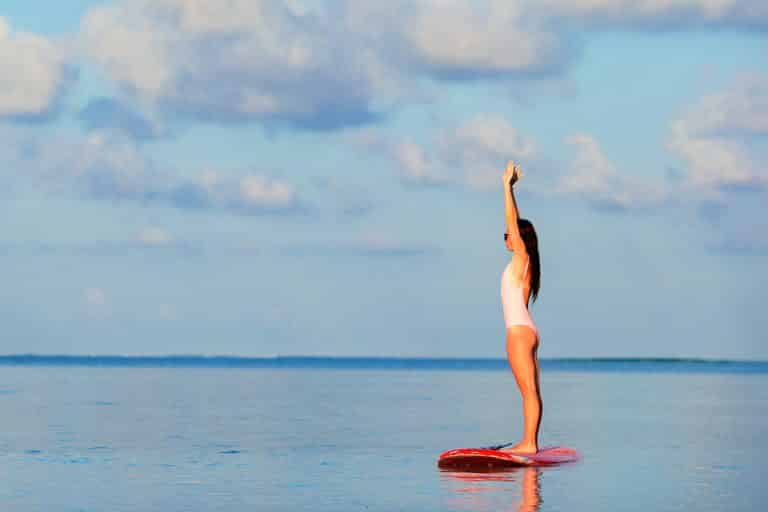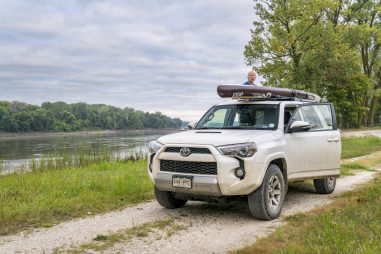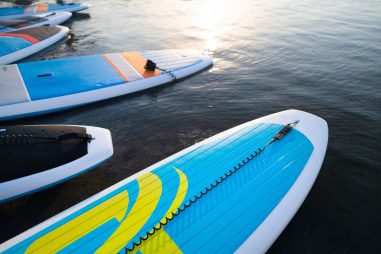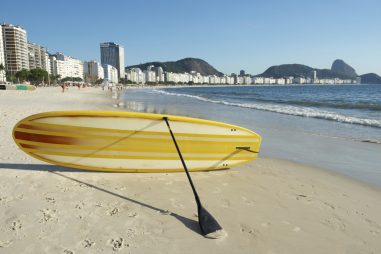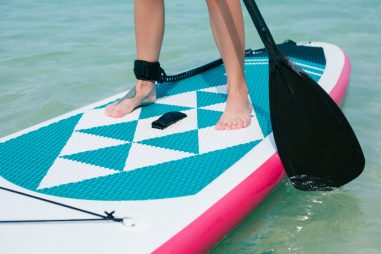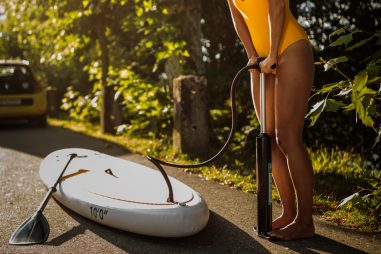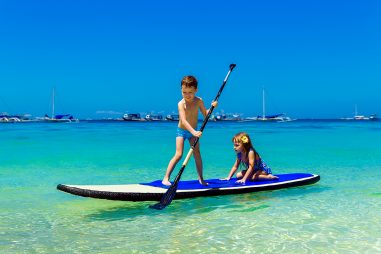Beginners favor wide paddle boards as they are more stable and easier to work with. The right paddle board for you will vary on several factors, like your weight and height, the width and length of the paddle board, the thickness, the shape of the board, the shape of the bottom, and the fins. Paddle boards with a lot of stability are a beginner’s best mate. A safe paddle board will help you learn faster. In addition, you will concentrate more on simple paddling strategy if you don’t have to worry about your balance.
Does Paddle Boarding Need Good Balance?
Balance is what keeps you afloat in the water. Therefore, it is essential that you have an excellent balance to keep yourself from falling off your board and into the water. Our lower body is working overtime to keep us upright on the board, while our upper body is mainly used for paddling.
Along with good balance, strength in the lower body is also vital as not to fall off your board. When paddle boarding, the legs may not seem to be working very hard, but they must keep pressing through the water in order for us to stay afloat.
Is It Easy to Fall Off a Paddle Board?
Paddle boarding seems to be a straightforward activity, but it is not. Beginners have a more challenging time staying on the board. If you are just starting, you might find yourself falling off a paddle board multiple times before you get the hang of it.
Don’t be discouraged! You are not alone; even experienced paddle boarders fall sometimes. After a few tries, you will feel confident and comfortable enough on the board, and you will be able to stay afloat. However, in the event or events that you inevitably fall, make sure to fall “right.” Check out these tips:
- Avoid the paddle board: It is best to fall away from your board and avoid falling on it. Doing this can help save you from unwanted injuries. So, the next time you feel you are about to fall, do your best to avoid the board.
- Be mindful of your board: If you choose to paddle with a leash, make sure to watch out for your board. Having a board leash is helpful, so the board comes back to you quickly but be careful not to get hit by it. Also, remember to shield your face from the board for protection!
- Falling flat is best: Reduce the chances of hitting anything below the water’s surface (such as rocks, reefs, etc.) by keeping your body shallow and falling flat on the water. Of course, you can’t go wrong with a belly flop or a back flop!
- Retrieve your board first: Some people hold on to their boards while they’re falling. That’s okay, too, but if you happen to fall away from it (like we discussed above), your next move should be to retrieve the board first, get back on the paddle board and retrieve your paddle.
How Do You Keep Balanced on a Paddle Board?
It is rare for someone to balance and stay balanced on a paddle board without any practice. But, as the saying goes, practice makes perfect! Listed below are a few tips to improve your balance:
- Get on the balance board: If you are unfamiliar with a balance board, it is a board that swings back and forth from a single balance position, giving the sensation of being on a swaying paddleboard. Balance boards will help you respond better to rough water and boat wakes by offering a fun, demanding workout that you can customize to your own balance weaknesses. Try practicing on the balance board a few times a week.
- Learn pivot or step back turns: A pivot turn requires you to step back into the board’s tail, soaking your board into the water for a moment while spinning in place. Learning pivot turns is relatively easy and will challenge your balance. However, they will also allow you to navigate the waters easily and make more powerful turns.
- Strengthen leg and core muscles: It is no surprise that your core keeps you balanced, so giving extra attention to training your body will prove beneficial to your paddle boarding. Don’t forget to train your legs as well!
- Do a balance challenge: Once you get the hand of balancing on calm, undisturbed water, you can up your game by paddling on boat wakes. Practicing paddling on boat wakes will help you get ready for the real stuff—dangerous and unpredictable water.
- Please don’t get discouraged: It will take some time before you become an expert but remember that everyone starts as a beginner. However, consistency coupled with patience will give you good results in the future!
You can also use exercise equipment to improve and test your balance. For example, you can choose from the list below:
- Balance Beams
- Balance Board
- Balance Pillows and Pads
- Bosu Balls
- Disc Pillow
- Revolution Balance Boards
- Rocker Balance Boards
- Wobble Board
How Hard Is It to Keep the Balance on a Paddle Board?
Paddle boarding is an excellent total-body exercise that engages all of your muscles, including those in your toes, hips, core, spine, shoulders, back, and neck. A base level of lower body strength and balance is needed to stand on a paddle board.
If you’re not very active or don’t work out often, you will have trouble paddling and staying balanced on the paddle board. Pushing yourself to the limit of your physical capabilities if you aren’t in shape will put you at risk of injury. However, continued practice can significantly improve balance as well as strength.
Are Paddle Boards Stable?
Paddle boards vary in stability. It also depends on the type of paddle boarding you will be doing. Generally, a wider paddle board is more stable compared to other types. A modest 30-32′′ width is appropriate for most paddlers.
However, paddle boards with a lot of widths are never easy. Paddle boards that are too large do not glide as much as narrow paddle boards. It’s for this reason that racing paddle boards are so narrow. If you are a beginner, start with a wide paddle board, switch to narrower boards when you get the hang of paddle boarding.
What Makes a Paddle Board Stable?
When shopping for a paddleboard, the recommended weight capacity is the best place to start. The greater a board’s recommended weight capacity, the more balanced and stable it can be compared to boards with smaller recommended weight capacities.
While it is common sense that the bigger a paddleboard is, the more stable it is, this is not necessarily true all the time. In the paddleboard industry, the recommended weight capacity does not yet have a standardized measurement to refer to. Some manufacturers list the maximum weight capacity for single paddlers, and others list the maximum weight capacity for all paddlers. However, there are several general recommendations to refer to when looking for a paddle board based on Weight Capacity Base Performance:
- Around 150 to 225: Recommended for younger people like teenagers and somewhat lighter adults 6 feet tall or below.
- Around 225 to 300: Best for people new to the sport. With seasoned paddlers, this can include a child or a pet
- Around 300 to 375: For beginners, they can bring a pet or a kid. For seasoned and experienced paddle boarders, they can go with another adult.
- 375 and higher: Recommended for tandem paddling for beginners and experienced paddlers.
Are Wider Paddle Boards More Stable?
The width of the board would have the most effect on its stability. In the water, the larger the board, the more stable and secure it would be. Since most paddleboards are small at the tail and nose, you’ll want to pay attention to the breadth of the midsection, which is where you’ll be standing when paddling.
Beginners should invest in boards that are at least 30 inches in width, and with larger or heavier paddlers would benefit most from boards that are 32 inches wide or larger.
Are Longer Paddle Boards More Stable?
\When it comes to overall stability, the length of a board is significant, but not as much as the width. A longer board is often more stable than a shorter board, but only if their widths are equal.
A board that is too long can be challenging to navigate or control, and it can also create stability issues, especially for beginners. If you’re new to paddle boarding, stick to an all-around length of 9’6″ to 11’6″.
What Is the Most Stable Paddle Board?
The most stable paddle board is the one that is right for your skill and also your weight. SUP boards with a length of 10-11 feet and a width of 32 to 34 inches are the most common for general use. If you value stability above all else, look for a board that measures 33-34 inches tall. Of course, you can go bigger, but you’ll likely end up with a slow board that’s less fun to paddle.
For beginners, you can follow the table below as a guide when purchasing your first board:
| Your Weight | Length | Width | Thickness |
| 56 kg and below
(125 lbs) |
9’6” – 10’9” | 31-32” | 5” |
| 56 – 68 kg
(125 – 150 lbs) |
9’6” – 10’9” | 31-32” | 5” |
| 68 – 79 kg
(150 – 175 lbs) |
10’ – 12’6” | 31-33” | 5” |
| 79 – 90 kg
(175 – 200 lbs) |
10’ – 12’6” | 32-34” | 5” |
| 90 – 102 kg 200 – 225 lbs |
10’ – 12’6” | 32-34” | 5-6” |
| 102 kg and above
(225 lbs +) |
10’ – 12’6” | 32-34” | 6” |
For more seasoned paddlers looking for a board that can be used for flat water sailing, mild surfing, and reasonable distance touring, here’s a general guide:
| Your Weight | Length | Width | Thickness |
| 56 kg and below
(125 lbs) |
9’6” – 10’9” | 29-32” | 5” |
| 56 – 68 kg
(125 – 150 lbs) |
9’6” – 11’ | 30-32” | 5” |
| 68 – 79 kg
(150 – 175 lbs) |
9’6” – 12’6” | 30-32” | 5” |
| 79 – 90 kg
(175 – 200 lbs) |
10’ – 12’6” | 30-33” | 5” |
| 90 – 102 kg 200 – 225 lbs |
10’ – 12’6” | 30-34” | 5-6” |
| 102 kg and above
(225 lbs +) |
10’ – 12’6” | 32-34” | 6” |
How Can I Make My Paddle Board More Stable?
It all comes down to the type of paddling you will be doing. When choosing a paddle board, you should take note of the type of paddling activity. If you are concerned with speed and straight tracking, then consider getting a race or touring board. A good size is 12’6″ and around 30″ – 32″ in width.
If you prioritize maneuverability and portability, then a 9’6″ board, 30″ – 32″ wide, might be the best option for you. However, apart from the thickness, width, and length, it would be best to consider some other factors: overall shape outline, inflatables vs. hardboards, paddle boards’ bottom shape (concave, belly, vee, or flat), and the fins.
How Do You Not Fall Off a Paddle Board?
In addition to improving balance and having the right, stable paddle board, you must also improve strength by incorporating stability exercise and resistance training into your routine. Paddle boarding requires various fitness components such as muscle stamina, aerobic health, strength, capacity, and balance, among other fitness components.
To stay balanced on your board, paddle boarding needs almost constant muscle usage. Except on calm and still waters, the water is constantly displaced from under you, and it is up to your lower body to hold you afloat. In addition, the water under each foot serves as individual resistance in paddle boarding, so each side of the body must work equally hard to maintain equilibrium, resulting in lower body strength. Review several lower-body exercises below that focus on various fitness elements, including lower-body strength and balance:
- Balance: Box Jumps and Single-Leg Deadlifts
- Cardio: Burpees and Tuck Jumps
- Muscular Endurance: Glute Bridge Holds, and Wall Sits or Wall Squats
- Power: Lunges or Jumping Lunges and Squat Jumps
- Strength: Lateral Squats and Weighted Step Ups
Will Paddle Boarding Get You Wet?
If you haven’t fallen off your board yet (which you will, eventually), you will still get wet, mainly in the lower part of your body. In addition, waves will hit against your board and cause rocking, thus splashing your feet, ankles, and legs with water.
Beginners start from kneeling on the board before getting the confidence to stand up. Remember, paddle boarding is a water sport. So, at some point, you will unavoidably get wet, and that is definitely okay!

